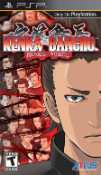Kenka Bancho: Badass Rumble Review
|
|
See PixlBit's Review Policies

On 11/10/2009 at 02:07 PM by Nick DiMola So, you're telling me that the whole point of the game is to wander around and pick fights with people, THEN beat the crap out of them!? Sign me up! |

Brawler fans and fans of Japanese culture should without question look into Kenka Bancho. Though the game offers depth within the genre, the genre itself is still shallow.
Kenka Bancho: Badass Rumble is the latest title from Atlus, a title they have done quite a bit of promotion for leading up to its official release. As a matter of fact, the Badass Rumble subtitle was a direct result of fan input. Since then, Atlus has continued to push the game with a variety of humorous productions centering on what a Bancho is, how to be one, and memoirs of one. Given all the hype, you should be wondering what it's all about.

When players take control of Kenka Bancho, they are thrust into a unique tutorial where Takashi Sakamoto, the protagonist, is taught by his father how to be a badass. This includes shooting lasers from your eyes (menchi-beam), smack talk, and of course, opening up a can of whoopass on whoever steps in your way. Following the tutorial, Sakamoto awakens from a daydream and finds himself on a train bound for Kyouto. The teen is en route to the metropolis as a part of a school trip.
Being a badass naturally means that you hate school trips and pretty much everyone you're there with, except of course, your Peon. The two of you will take to the streets in order to make you the best Bancho in the city. Luckily there are 47 other prospective Banchos in town, just waiting for a fight. In order to accomplish this goal, players will need to walk around and pick fights with everyone and anyone, and win in order to raise their Bancho level in an RPG-like fashion.

Players will have a total of seven days (the duration of the trip) in order to complete their goal. Each day players will beat the crap out of just about anyone in hopes that they will find the itinerary of a Bancho located in another section of town. This will allow the player to know when and where to find them so they may beat them, make them their Peon, and move up the Bancho ladder.
Kenka Bancho is most definitely a crazy game. At its core it's a street brawler, but one that mixes up the formula with some unique RPG elements. Kyouto is an open-ended, sandbox city that allows players to come and go as they please. Unfortunately, due to the fact that they are on a school trip, each day is structured. This means that players are always on a strict schedule, requiring them to return to the hotel at certain times, and participate in certain events on certain days. These events include daytrips with your class to various locales around Kyouto. Of course, plenty of badassery can still take place on the daytrips, and though there are no Banchos to tackle, they provide for a great place to pick up itineraries for others around town.

Aside from the schedule, there are a few things that set Kenka Bancho apart from other titles in its genre. Similar to God Hand, as players progress through the game, they will acquire new moves (i.e. punches, kicks, etc) which they can then use in their combo strings. This works as a second RPG element to the general one, where players earn experience for successfully besting other street brawlers and Banchos. The system works incredibly well and acts as constant encouragement to fight and make oneself stronger. The fact that players can customize their own combo string was also quite appealing; coincidentally, it was also one of my favorite aspects of God Hand.
In addition to combo strings, players also have a confidence/respect meter which fluctuates depending on a players overall performance and how well they fight. This impacts the eye-laser function, which helps to either engage an enemy, subsequently forcing a smacktalk session, or dissuades them from even fighting. The difficulty of a smacktalk session is also dependent on a player's confidence/respect meter as well.

Smacktalk is done by pushing the proper button at a particular time in order to construct a message to your enemy. The message is briefly flashed before you start, giving players a roadmap for what they must input at the next three prompts. This is a timed affair and, once again, depending on the level of a player's confidence/respect meter, the challenge will be easier or harder. Success will allow the player to land the first blow in battle, whereas failure will allow the opponent to knock the player to the ground.
At the end of the day, though Kenka Bancho has a number of unique elements, it's still a brawler. While it's fun, it has limited appeal and players won't likely want to extend play sessions longer than 30-45 minutes. Those looking for such a game, particularly one with a distinctive Japanese vibe, will find themselves greatly enjoying Kenka Bancho.










Comments